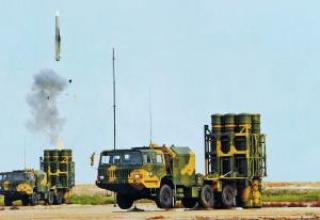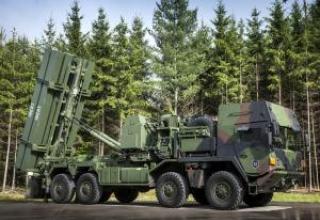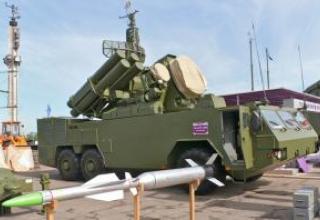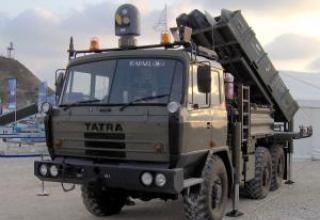Self-propelled medium range anti-aircraft missile system Chu-SAM (Type-03) is designed to engage a wide range of air targets, including low-flying cruise and ballistic missiles for operational and tactical purposes, in conditions of massive raid, in a difficult interference environment in any weather at a range of up to 50 km. Chu-SAM is designed to replace outdated "Hawk" complexes, in the Japanese air defense system is complemented by "Patriot PAC-3" and Tan-SAM.
Development of the complex began in 1990 at TRDI (Technical Research and Development Institute) of the Japanese Defense Agency together with Mitsubishi Electronics Corporation. The development program of the complex worth about $10.7 billion provided for the completion of tests of Chu-SAM SAMs in 1999 and deployment of the complex in 2002. The complexity of the tasks to be solved and problems with financing led to delays in the development period. As a result, the testing of the complex started only in 2001 at the White Sands test site (USA, New Mexico). In 2003, the complex was launched into production.
Chu-SAM (Type-03) SAM system was adopted by Japanese self-defense forces in 2005.
Composition:
The complex consists of:
- launchers (see photo),
- transport and charging machines (see photo),
- fire control point (see photo),
- multifunction radar (see photo).
All combat vehicles of Chu-SAM are made on cross-country vehicle chassis (8x8). The multifunctional radar is equipped with an active phased antenna array. The radar provides search and simultaneous tracking of up to 100 air targets, allows to assess the threat level and provide firing of 12 of them.
Information about the air situation, technical condition of the complex elements and availability of ready to launch missiles is displayed on the fire control station displays. Modern software of the complex expands the possibilities of over-the-horizon firing, allows to predict the location of the target, taking into account preloaded topographic information about the terrain of the theater of war and lead the missile to the predicted point of meeting. The complex is equipped with communications equipment for interfacing with DRLO and control aircraft, as well as with ships equipped with the Aegis multifunctional weapon system.
The launcher accommodates a package of six transport and launch containers (TLCs) of rectangular cross-section with missiles. Before the launch, the launcher is horizontally positioned using four hydraulic jacks, and the TIC package is positioned vertically. The launch of the rocket from the container is hot. In the lower part of the container package is a special gas deflector, which provides the jet of the engine of the launch vehicle from the launcher.
The rocket is a solid fuel single-stage, the maximum flight speed - 2.5M. ZUR is equipped with an active radar homing head, borrowed from the missile Type-99 class "air-to-air". The weight of the missile - 580kg, length - 4900mm, hull diameter - 300mm. Availability of thrust vector control system and developed all-terrain front (see photo) and rear (see photo) aerodynamic steering surfaces provide Chu-SAM missile with high maneuverability.
The missile is launched vertically and then tilted towards the target by the Chu-SAM. The missile is controlled by an inertial control system until the target is picked up by the homing head to the primary designation data transmitted to the missile. The data transmission line is used to transmit correction commands to the missile in the middle section of the trajectory before the homing head captures the target.
The number of calculations has been reduced due to the high level of automation of the entire combat cycle.
Characteristics:
| Defeat range, km | 50 |
| Defeat height maximum, km | 10 |
| The length of the rocket, mm | 4900 |
| Body diameter, mm | 300 |
| Launch weight of the rocket, kg | 580 |
| Flight Speed | 2.5М |
Testing:
The first combat use of the S-200 SAM system took place in 1982 in Syria, where at a distance of 190 km the E-2C "Hawkeye" DRLO was shot down, after which the American aircraft carrier fleet withdrew from the Lebanese coast. The Libyan S-200 complexes took part in repulsing an attack by American FB-111 bombers and possibly shot down one bomber.
On the basis of the 5B28 anti-aircraft missile of the S-200B complex a hypersonic flying laboratory "Cold" has been created to test hypersonic direct-flow air jet engines. The choice of this missile was based on the fact that the parameters of its flight path were close to those required for flight tests of the Hyper-Sonic Propulsion System. It was also considered important that the missile had been decommissioned and its cost was low. The missile's combat unit was replaced by the head compartments of the GLL "Kholod", which housed the flight control system, a liquid hydrogen tank with displacement system, a hydrogen flow control system with measuring devices and, finally, the experimental HPVRD E-57 of axially symmetric configuration.
Sources:
- Алексеев Я., Данилов О. "Состояние и перспективы развития зарубежных ЗРК большой с средней дальности" .Зарубежное военное обозрение 2006 №11 с.35-43
- Chu-SAM (Japan), Static and towed surface-to-air missile systems











